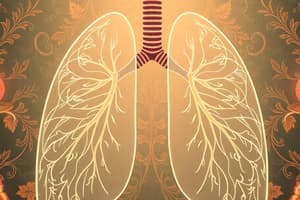Podcast
Questions and Answers
In obstructive lung diseases, what is the primary physiological challenge a patient faces?
In obstructive lung diseases, what is the primary physiological challenge a patient faces?
- Difficulty fully expanding the lungs during inhalation, leading to reduced tidal volume.
- Reduced oxygen-carrying capacity in the blood due to damaged erythrocytes.
- Inability to efficiently exhale air from the lungs, leading to air trapping. (correct)
- Increased diffusion rate of oxygen across the alveolar membrane due to inflammation.
Which of the following factors would have the least impact on hemoglobin's oxygen saturation?
Which of the following factors would have the least impact on hemoglobin's oxygen saturation?
- The partial pressure of oxygen in the surrounding environment.
- The concentration of elastin within the alveolar walls. (correct)
- The amount of iron ions in the heme group of hemoglobin.
- The number of red blood cells present in the bloodstream.
A patient presents with significantly reduced forced vital capacity but normal tidal volume. Which condition is least likely to be the primary cause?
A patient presents with significantly reduced forced vital capacity but normal tidal volume. Which condition is least likely to be the primary cause?
- Asthma, causing airway narrowing. (correct)
- Neuromuscular disorder affecting respiratory muscle strength.
- Emphysema, causing loss of alveolar elasticity.
- Pulmonary fibrosis, restricting lung expansion.
How does emphysema directly affect the process of gas exchange in the lungs?
How does emphysema directly affect the process of gas exchange in the lungs?
If atmospheric pressure is 760 mm Hg, and oxygen comprises 21% of the air, approximately what is the partial pressure of oxygen (PO2)?
If atmospheric pressure is 760 mm Hg, and oxygen comprises 21% of the air, approximately what is the partial pressure of oxygen (PO2)?
Which of the following scenarios would most likely lead to a decrease in the amount of oxygen bound to hemoglobin?
Which of the following scenarios would most likely lead to a decrease in the amount of oxygen bound to hemoglobin?
How does the loss of elastin in emphysema directly contribute to the difficulty in exhaling?
How does the loss of elastin in emphysema directly contribute to the difficulty in exhaling?
A patient's spirometry results show a normal FEV1/FVC ratio but a significantly reduced FVC. What is the most likely underlying condition?
A patient's spirometry results show a normal FEV1/FVC ratio but a significantly reduced FVC. What is the most likely underlying condition?
What is the role of simple diffusion in the context of respiration?
What is the role of simple diffusion in the context of respiration?
How would an increase in altitude affect the partial pressure of oxygen (PO2) and, consequently, oxygen saturation in a healthy individual?
How would an increase in altitude affect the partial pressure of oxygen (PO2) and, consequently, oxygen saturation in a healthy individual?
Flashcards
Spirometer
Spirometer
Measures lung volumes, including tidal volume and forced vital capacity.
Tidal Volume
Tidal Volume
The amount of air inhaled during normal breathing.
Forced Vital Capacity (FVC)
Forced Vital Capacity (FVC)
Max air exhaled with force.
Obstructive Lung Disease
Obstructive Lung Disease
Signup and view all the flashcards
COPD
COPD
Signup and view all the flashcards
Emphysema
Emphysema
Signup and view all the flashcards
Asthma
Asthma
Signup and view all the flashcards
Restrictive Lung Disease
Restrictive Lung Disease
Signup and view all the flashcards
Pulmonary Fibrosis
Pulmonary Fibrosis
Signup and view all the flashcards
Partial Pressure
Partial Pressure
Signup and view all the flashcards
Study Notes
- Spirometer measures several lung volumes
Lung Volumes
- Tidal volume: amount of air breathed in normal inhalation.
- Tidal volume is 500 mL.
- Forced vital capacity measures lung's ability to exhale.
- Inspiratory Reserve Volume: 2700 mL
- Expiratory Reserve Volume: 1200 mL
- Residual volume: Volume of air left which cannot leave
Breathing Air
- Normal breath utilizes only Tidal Volume
- Deepest inhalation utilizes Inspiratory Reverse Volume
- Deepest exhalation utilizes Expiratory Reserve Volume
Obstructive Lung Disease
- Difficult for someone to exhale air quickly
- Examples include Chronic Obstructive Pulmonary Disease (COPD). COPD is an umbrella term for many types of diseases.
- Risk factors include smoking, exposure to occupational fumes, dust, airborne particles, household air pollution.
- Emphysema involves a loss of elastin (a protein with elastic properties), found in walls of alveoli
- Asthma means airways become narrowed due to smooth muscle contractions.
Restrictive Lung Disease
- Affects inhalation.
- Pulmonary fibrosis is an example
Blood
- Red blood cells, also known as erythrocytes, carry most oxygen.
- Hemoglobin is contained inside these cells.
- Oxygen binds to iron in the heme group.
- Each hemoglobin can carry 4 molecules of O2.
- PO2 surrounding affects hemoglobin saturation (amount of O2 returning to lungs).
Partial Pressures
- Atmospheric pressure refers to pressure of air breathed from the atmosphere
- The partial pressure of O2 refers to how much pressure oxygen contributes to total atmospheric pressure.
- The partial pressure of CO2 refers to how much pressure carbon dioxide contributes to total atmospheric pressure.
- Calculated as: 760 x 21 = 160
- Calculated as: 760 x 0.04 = 0.3
Simple Diffusion
- Large concentration gradient: PO2 is very high inside alveoli, much lower in blood found in capillaries that wrap around alveoli
- Lots of membrane area: millions of alveoli, enormous amount of membrane
- Thin membrane thickness: epithelial, and endothelial cells make the alveolar wall
Studying That Suits You
Use AI to generate personalized quizzes and flashcards to suit your learning preferences.
Related Documents
Description
This lesson covers lung volumes, including tidal volume, inspiratory reserve volume, expiratory reserve volume, and residual volume. It also discusses obstructive lung diseases like COPD, emphysema, and asthma, along with their risk factors.




